Chelyabinsk
| Chelyabinsk Челябинск (Russian) | |
|---|---|
| - City[1] - | |
 Chelyabinsk Opera Theater and vicinity | |
 Chelyabinsk | |
.svg.png) |
 |
Coat of arms |
Flag |
| City Day | September 13 |
| Administrative status (as of September 2011) | |
| Country | Russia |
| Federal subject | Chelyabinsk Oblast |
| Administratively subordinated to | City of Chelyabinsk[1] |
| Administrative center of | Chelyabinsk Oblast,[1] City of Chelyabinsk[1] |
| Municipal status (as of September 2011) | |
| Urban okrug | Chelyabinsky Urban Okrug[1] |
| Administrative center of | Chelyabinsky Urban Okrug[1] |
| Head | Stanislav Mosharov |
| Representative body | Council |
| Statistics | |
| Area | 530 km2 (200 sq mi)[2] |
| Population (2010 Census) | 1,130,132 inhabitants[3] |
| - Rank in 2010 | 9th |
| Population (2013 est.) | 1,156,201 inhabitants[4] |
| Density | 2,132/km2 (5,520/sq mi)[5] |
| Time zone | YEKT (UTC+05:00)[6] |
| Founded | 1736[7] |
| City status since | 1787[7] |
| Postal code(s)[8] | 454xxx |
| Dialing code(s) | +7 351[9] |
| Website |
www |
| Chelyabinsk on Wikimedia Commons | |
Chelyabinsk (Russian: Челя́бинск, IPA: [tɕɪˈlʲæbʲɪnsk] (![]()
History
The fortress of Chelyaba, from which the city takes its name, was founded at the location of the Bashkir village of Chelyaby (Bashkir: Силәбе, Siläbe) by colonel Alexey (Kutlu-Muhammed) Tevkelev in 1736[7] to protect the surrounding trade routes from possible attacks by Bashkir outlaws. During Pugachev's Rebellion, the fortress withstood a siege by the rebel forces in 1774, but was eventually captured for several months in 1775. In 1782, as a part of Ufa Viceroyalty that was later reformed into Orenburg Governorate, Chelyabinsk became a seat of a its own uyezd and finally was granted town status and its current name in 1787.
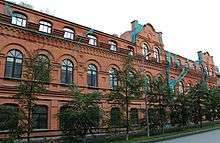
Until the late 19th century, Chelyabinsk was a small provincial town. In 1892, the Samara-Zlatoust Railway was completed which connected it with Moscow and the rest of European Russia. Also in 1892, construction of the Trans-Siberian Railway from Chelyabinsk started and in 1896 the city was linked to Ekaterinburg. Chelyabinsk became the hub for relocation to Siberia. For fifteen years more than fifteen million people - a tenth of Russia - passed through Chelyabinsk. Some of them remained in Chelyabinsk, which contributed to its rapid growth. In addition, in Chelyabinsk was organized custom office set "customs fracture" the bounding duty-free grain and tea to the European part of the country that led to the emergence in mills and set the tea-packing factory. Soon Chelyabinsk started turning into a major trade center, its population reached 20,000 inhabitants by 1897, 45,000 by 1913, and 70,000 by 1917. For rapid growth at the turn of the 20th century, similar to American cities, Chelyabinsk called "Behind the Urals Chicago".[15]
During the first Five-Year Plans of the 1930s, Chelyabinsk experienced rapid industrial growth. Several establishments, including the Chelyabinsk Tractor Plant and the Chelyabinsk Metallurgical Plant, were built at this time. During World War II, Joseph Stalin decided to move a large part of Soviet factory production to places out of the way of the advancing German armies in late 1941. This brought new industries and thousands of workers to Chelyabinsk. Facilities for the production of T-34 tanks and Katyusha rocket launchers existed in Chelyabinsk. During World War II, it produced 18,000 tanks, and 48,500 tank diesel engines as well as over 17 million units of ammunition. In the press of the time Chelyabinsk was informally called "Tankograd" or "Tank City". The S.M. Kirov Factory no. 185 moved here from Leningrad to produce heavy tanks; it was transferred to Omsk after 1962.
2013 meteor
Shortly after dawn on February 15, 2013, a superbolide meteor descended at over 55,000 kilometers per hour (34,000 mph) over the Ural Mountains, exploding at an altitude of 25–30 kilometers (16–19 mi).[16]
The meteor created a momentary flash as bright as the sun and generated a shock wave that injured over a thousand people. Fragments fell in and around Chelyabinsk. Interior Ministry spokesman Vadim Kolesnikov said 1,100 people had called for medical assistance following the incident, mostly for treatment of injuries from glass broken by the explosions. One woman suffered a broken spine.[17] Kolesnikov also said about 600 square meters (6,000 sq ft) of a roof at a zinc factory had collapsed. A spokeswoman for the Emergency Ministry told the Associated Press that there was a meteor shower; however, another ministry spokeswoman was quoted by the Interfax news agency as saying it was a single meteor.[18][19][20] The size has been estimated at 17 meters (56 ft) diameter with a mass of 10,000[21][22] or 11,000[23] metric tons. The power of the explosion was about 500 kilotons of TNT (about 1.8 PJ), which is 20–30 times more energy than was released from the atomic bomb exploded in Hiroshima. Luckily, thanks to the high altitude of the explosion the city managed to avoid large casualties and destruction.
Administrative and municipal status
Chelyabinsk is the administrative center of the oblast.[1] Within the framework of administrative divisions, it is incorporated as the City of Chelyabinsk—an administrative unit with the status equal to that of the districts.[1] As a municipal division, the City of Chelyabinsk is incorporated as Chelyabinsky Urban Okrug.[1] In June 2014, Chelyabinsk's seven city districts were granted municipal status.[24]
Geography and сlimate
Chelyabinsk is located east of the Ural Mountains, 199 km south of Yekaterinburg. Its elevation is 200–250 meters.
The city is bisected by the river Miass which is regarded as the border between the Urals and Siberia. This is reflected in the geology of the place, with low granite hills of the Urals on the western side and lower sedimentary rock of the West Siberian Plain on the eastern side.
The "Leningrad bridge" connects the two sides, so it is called the "bridge of the Urals to Siberia". Chelyabinsk itself is therefore also known as "The Gateway to Siberia".[25]
Like Rome, Constantinople, and Moscow, Chelyabinsk is said to be located on seven hills.[26]
| Climate data for Chelyabinsk | |||||||||||||
|---|---|---|---|---|---|---|---|---|---|---|---|---|---|
| Month | Jan | Feb | Mar | Apr | May | Jun | Jul | Aug | Sep | Oct | Nov | Dec | Year |
| Record high °C (°F) | 4.9 (40.8) |
5.6 (42.1) |
19.9 (67.8) |
34.9 (94.8) |
39.9 (103.8) |
39.9 (103.8) |
39.9 (103.8) |
39.9 (103.8) |
34.9 (94.8) |
24.9 (76.8) |
14.9 (58.8) |
9.9 (49.8) |
39.9 (103.8) |
| Average high °C (°F) | −10.5 (13.1) |
−7.9 (17.8) |
1.0 (33.8) |
10.6 (51.1) |
20.3 (68.5) |
23.9 (75) |
25.2 (77.4) |
23.6 (74.5) |
17.2 (63) |
9.3 (48.7) |
−0.4 (31.3) |
−6.9 (19.6) |
8.8 (47.8) |
| Daily mean °C (°F) | −14.9 (5.2) |
−13.4 (7.9) |
−4.8 (23.4) |
4.7 (40.5) |
12.1 (53.8) |
18.3 (64.9) |
19.3 (66.7) |
17.1 (62.8) |
10.9 (51.6) |
4.1 (39.4) |
−5.2 (22.6) |
−11.1 (12) |
3.0 (37.4) |
| Average low °C (°F) | −19.0 (−2.2) |
−18.9 (−2) |
−9.3 (15.3) |
−0.3 (31.5) |
7.9 (46.2) |
12.9 (55.2) |
14.5 (58.1) |
13.5 (56.3) |
7.6 (45.7) |
1.3 (34.3) |
−5.9 (21.4) |
−14.6 (5.7) |
−0.9 (30.4) |
| Record low °C (°F) | −49.9 (−57.8) |
−44.9 (−48.8) |
−44.9 (−48.8) |
−29.9 (−21.8) |
−19.9 (−3.8) |
−4.9 (23.2) |
0.1 (32.2) |
0.1 (32.2) |
−9.9 (14.2) |
−24.9 (−12.8) |
−39.9 (−39.8) |
−44.9 (−48.8) |
−49.9 (−57.8) |
| Average precipitation mm (inches) | 17 (0.67) |
16 (0.63) |
19 (0.75) |
27 (1.06) |
47 (1.85) |
55 (2.17) |
87 (3.43) |
44 (1.73) |
41 (1.61) |
30 (1.18) |
26 (1.02) |
21 (0.83) |
430 (16.93) |
| Average rainy days | 0.1 | 0.3 | 4 | 10 | 15 | 19 | 17 | 16 | 16 | 10 | 6 | 1 | 114 |
| Average snowy days | 18 | 16 | 15 | 6 | 1 | 0.3 | 0 | 0 | 1 | 6 | 15 | 19 | 97 |
| Average relative humidity (%) | 85 | 77 | 76 | 66 | 61 | 64 | 69 | 71 | 73 | 73 | 82 | 83 | 73 |
| Source #1: Pogoda.ru.net[27] | |||||||||||||
| Source #2: World Meteorological Organization (precipitation days only)[28] | |||||||||||||
Cityscape

Architecture
The architecture of Chelyabinsk has been shaped through its history by the change of historical eras in the development of Russia. Before the revolution of 1917 the city was a trading centre, with numerous merchant buildings in the eclectic and modern styles with elements of Russian Revival architecture, some of which are preserved on Kirovka St., a street reserved for pedestrians.
Industrialization started in the late 1920s. The construction of large plants was accompanied by the construction of a brand new residential and public buildings in the constructivist style. Entire constructivist neighborhoods can be seen in the area of the Chelyabinsk Tractor Plant (CTZ, ChTZ).[29]
In the late 1930s a new era began in the city, came associated with construction of monumental buildings in Stalinist style. The city center and central avenue are constructed in substantially this style.[30]
The next 60 years saw intensive construction of housing tower blocks as the city's population rose to about one million; note on the map the large residential area calle "Severo-Zapad" (English: North-West).
.jpg)
With the market reforms of the '90s the city began intensive construction of office buildings for business and major shopping malls in postmodern and high-tech styles.
Parks and gardens
Chelyabinsk has seventeen public parks. The largest of them is one of the best in Russia - Chelyabinsk Central Park, named after Gagarin.[31] Its territory is saved in the urban forest, where, among pine trees and granite rocks there are several picturesque ex-quarries now flooded with water.
Education

There are over a dozen universities in Chelyabinsk. The oldest, Chelyabinsk State Agroengineering Academy, was founded in 1930. It was followed by the Chelyabinsk State Pedagogical University in 1934. The main ones are South Ural State University, Chelyabinsk State University, and Chelyabinsk Medical Academy. After World War II, Chelyabinsk became the main center of vocational education of the entire Ural region.[32]
Economy
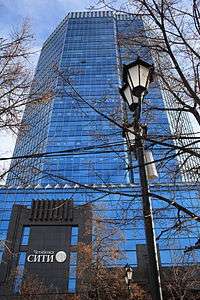
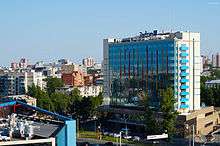
Chelyabinsk is one of the major industrial centers of Russia. Heavy industry predominates, especially metallurgy and military machinery, notably the Chelyabinsk Metallurgical Combinate (CMK, ChMK) belongs to the company "Mechel", Chelyabinsk Tractor Plant (CTZ, ChTZ), Chelyabinsk Electrode plant (CHEZ), Chelyabinsk Tube Rolling Plant (ChTPZ) included in the "Big Eight" pipe producers in Russia, produces large-diameter pipes for pipelines, and Chelyabinsk Forge-and-Press Plant (ChKPZ) manufacturer of parts for various machines. Chelyabinsk Zinc Plant, owned by the Ural Mining and Metallurgical Company, produces about 2% of the world and over 60% of Russian zinc. Chelyabinsk Mechanical Plant produces automotive and industrial cranes trademark "Chelyabinets". Chelyabinsk road machinery plant name Kolyuschenko produces road construction machinery and dump trucks Terex.[33]
Chelyabinsk Watch Factory "Molnija" produces pocket, souvenir watches and technical watches for aircraft and ships. In 1980, the clock "Molnija" were given as gifts to participants of the Moscow Olympic Games.[34]
Agro-industrial company "Makfa", Russia's largest producer of pasta, one of the five largest world producers of pasta. "Unichel" shoe firm is the largest manufacturer of footwear in Russia. Agricultural firm "Ariant" - leader in the production of meat products in the Urals Federal District of Russia, produces alcoholic and non-alcoholic beverages. American multinational corporation Emerson buying up shares of local businesses "Metran" organized in Chelyabinsk engineering center, building a factory for the production of industrial devices and equipment.[35]
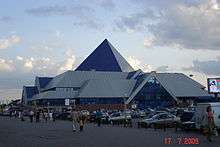

In recent years, Chelyabinsk significant role in the economy of the early play services, banking and insurance activities, logistics centers, tourism. The city is the central offices of major regional banks as "Chelindbank" and "Chelyabinvestbank".
There are several large shopping malls. The largest of them are Gorky (English: Hills) (2007), with an area of 55,000 meters2, and Rodnik (English:Spring) (2011), 135,000 meters2. At least two more are under construction: Almaz (English: Diamond) (2015), 220,000 meters2, and Cloud (2018), 350,000 meters2.
Transportation
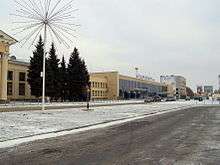
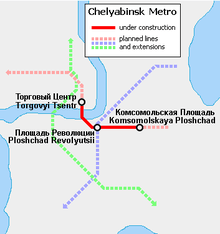
Public transport of Chelyabinsk is represented by a bus lines network (since 1925), tram (1932) and trolleybus (1942) systems, as well as private marshrutka (routed cab) services. The city has several taxi companies.
In 2014 in Chelyabinsk began to run electric buses (hybrid trolleybus and electric car).[36]
Beeline and Chelyabinsk city electric transport in 2011 signed an agreement to provide passengers free internet. Currently Wi-Fi is available in some public trams and trolleybuses in Chelyabinsk.
Chelyabinsk started construction of a three-line subway network in 1992.[37]
The city is served by the Chelyabinsk Airport.
Sports
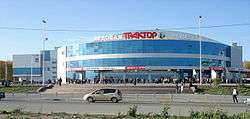
Several sports clubs are active in the city:
| Club | Sport | Founded | Current League | League Rank | Stadium |
|---|---|---|---|---|---|
| Traktor Chelyabinsk | Ice Hockey | 1947 | Kontinental Hockey League | 1st | Traktor Arena |
| Chelmet Chelyabinsk | Ice Hockey | 1948 | Higher Hockey League | 2nd | Yunost Sports Palace |
| Belye Medvedi Chelyabinsk | Ice Hockey | 2009 | Junior Hockey League | Jr. 1st | Traktor Arena |
| Mechel Chelyabinsk | Ice Hockey | 2011 | Junior Hockey League Division B | Jr. 2nd | Mechel Ice Palace |
| FC Chelyabinsk | Football | 1977 | Russian Second Division | 3rd | Central Stadium |
| Sintur Chelyabinsk | Futsal | 1997 | Futsal Supreme League | 2nd | USURT Sports Complex |
| Metar Chelyabinsk | Volleyball | 1976 | Women's Volleyball Superleague | 1st | Metar-Sport Sports Palace |
| Torpedo Chelyabinsk | Volleyball | ? | Men's Volleyball Supreme League | 2nd | Metar-Sport Sports Palace |
| Dynamo Chelyabinsk | Basketball | ? | Men's Basketball Superleague - B | 3rd | DPSh im.Krupskoy |
In 2012, for the first time in Russia, Chelyabinsk hosted the European Judo Championship (Euro 2012). In 2014 the World Championship in Judo were held and in 2015 the European Speed Skating Championships as well as the World Taekwondo Championships held. IIHF World U18 Championship will be held in 2018 (along with Magnitogorsk).
Culture
The city has several libraries, including Chelyabinsk Regional Universal Scientific Library, with more than 2 million books, including more than 12,000 rare books and monuments (17th to 19th centuries), is the largest public library in the Chelyabinsk oblast.
Chelyabinsk is home to several popular theaters: Chelyabinsk State Academic Drama Theatre named Nahum Orlov, Chelyabinsk State Academic Opera and Ballet Theatre named Glinka, Chelyabinsk State Chamber Theater Drama, Chelyabinsk State Puppet Theater, Chelyabinsk State Youth Theatre, Theater "Mannequin", Chelyabinsk New Arts Theatre, Chelyabinsk Contemporary Dance Theatre.
There are nine museums in Chelyabinsk. Chelyabinsk regional museum was founded in 1913, and holds about 300 thousand exhibits. There are expositions of the ancient settlement Arkaim age 3rd to 2nd millennium BC relating to the "Land of Cities", the largest fragment of the Chelyabinsk meteor, weighing 570 kg, famous decorated edged weapons of the 19th and 20th centuries, made by Zlatoust arms factory, exhibits Kasli artistic cast iron and much more. Chelyabinsk Region Picture Gallery has more than 11,000 works. Meeting up collections of art in Europe and the East (International Art), the national art of the Middle Ages, modern and contemporary, modern art. The peculiarity of the meeting are collections of icons (16th to 20th centuries), early printed books and manuscripts. The museum of railway equipment of the South Ural railway presented more than 30 exhibits of vehicles used on the rail after it in Chelyabinsk in 1892.
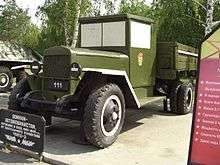
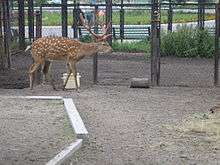
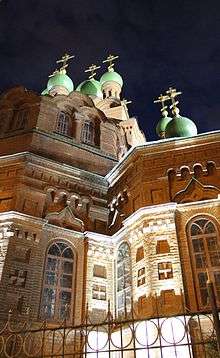
Museum of military equipment in the garden of Victory was founded in 2007. It is 16 eksponantov, including T-34, IS-3 tanks and multiple rocket launchers "Katyusha" produced in Chelyabinsk during the World War II.
In addition, the city has the Chelyabinsk regional geological museum, museum of military glory of labor and the Chelyabinsk Tractor Plant, Museum postal service Chelyabinsk region, entertaining science museum "Eksperimentus".
Chelyabinsk Zoo is located in the central region of Chelyabinsk. Has an area of 30 hectares with more than 110 species, of which more than 80 listed in the Red Book. Zoo participates in international programs for the conservation of endangered species, including Amur (Siberian) tigers, Far Eastern leopards and Polar bears. The zoo regular sightseeing tours, lectures, exhibitions and celebrations.
City also has a circus building and a Concert Hall. Prokofiev Hall of organ and chamber music with organ-known German company "Hermann Eule". The instrument consists of 2504 pipes, 37 registers, three manuals and pedal keyboard. Its sound is a rare gentleness and generosity sound basic votes.
In the city of Chelyabinsk there are several churches built in the 19th to 21st centuries.
Notable people
- Ariel, Soviet pop rock band
- Lera Auerbach (born 1973), composer and musician, born and grew up in Chelyabinsk
- Svyatoslav Belza (1942–2014), musical scholar, critic and essayist, born in Chelyabinsk
- Zhan Bush (born 1993), figure skater
- Yekaterina Gamova (born 1980), Olympic volleyball player, born and grew up in Chelyabinsk
- Makhmut Gareev (born 1923), historian and military scientist, born and grew up in Chelyabinsk
- Viktor Khristenko (born 1957), politician, Minister of Industry of the Russian Federation, born and grew up in Chelyabinsk
- Igor Kurnosov (1985–2013), chess grandmaster, born in Chelyabinsk
- Oleg Mityaev (born 1956), singer-songwriter and actor, born, grew up, and came into prominence in Chelyabinsk
- Vadim Muntagirov (born 1990), ballet dancer, born in Chelyabinsk
- Staņislavs Olijars (born 1979), Latvian 110m hurdler, gold medallist at the 2006 European Athletics Championships, born in Chelyabinsk
- Georgy Ratner (1923–2001), surgeon, born in Chelyabinsk
- Nelli Rokita (born 1957), Polish politician, born in Chelyabinsk
- Eugene Roshal, software developer, born in Chelyabinsk
- Mariya Savinova, Olympic athlete, born in Chelyabinsk
- Galina Starovoytova (1946–1998), politician and human rights activist, born in Chelyabinsk
- Maksim Surayev (born 1972), cosmonaut, born in Chelyabinsk
- Evgeny Sveshnikov (born 1950), chess grandmaster and writer, born and grew up in Chelyabinsk
- Anna Trebunskaya (born 1980), ballroom and Latin dancer, born in Chelyabinsk
- Ivan Ukhov (born 1986), Olympic high jumper, born in Chelyabinsk
- Mikhail Yurevich (born 1969), businessman, politician, born in Chelyabinsk
Ice hockey players
- Sergei Babinov (born 1955), Soviet player, Canada Cup champion
- Vyacheslav Bykov (born 1960), Soviet player
- Stanislav Chistov (born 1983), NHL and KHL player
- Evgeny Davydov (born 1967), NHL player, USSR champion
- Sergei Gonchar (born 1974), NHL player, Stanley Cup champion
- Dmitri Kalinin (born 1980), NHL and KHL player, Gagarin Cup champion
- Alexandra Vafina (born 1990), Russian Olympic ice hockey player (2010, 2014)
- Evgeny Kuznetsov (born 1992), NHL and KHL player, Stanley Cup champion
- Sergei Makarov (born 1958), NHL player
- Andrei Nazarov (born 1974), NHL player and KHL coach
- Nikita Nesterov (born 1993), NHL and KHL player
- Valeri Nichushkin (born 1995), NHL and KHL player
- Valeri Karpov (1971–2014), Russian Superleague and NHL player
- Dmitri Tertyshny (1976–1999), Russian Superleague and NHL player
- Slava Voynov (born 1990), NHL player, Stanley Cup champion
- Danil Yerdakov (born 1989), KHL player
- Danis Zaripov (born 1981), KHL player, Gagarin Cup champion
Twin towns and sister cities
Chelyabinsk is twinned with:







Diplomatic and consular missions and visa centers
See also
References
Notes
- 1 2 3 4 5 6 7 8 9 Resolution #161
- ↑ "Челябинск сегодня – Визитная Карточка". Администрация г. Челябинска. Archived from the original on February 3, 2012.
- 1 2 Russian Federal State Statistics Service (2011). "Всероссийская перепись населения 2010 года. Том 1" [2010 All-Russian Population Census, vol. 1]. Всероссийская перепись населения 2010 года (2010 All-Russia Population Census) (in Russian). Federal State Statistics Service. Retrieved June 29, 2012.
- ↑ Численность населения Российской Федерации по муниципальным образованиям на 1 января 2013 года. — М.: Федеральная служба государственной статистики Росстат, 2013. — 528 с. (Табл. 33. Численность населения городских округов, муниципальных районов, городских и сельских поселений, городских населенных пунктов, сельских населенных пунктов)
- ↑ The value of density was calculated automatically by dividing the 2010 Census population by the area specified in the infobox. Please note that this value may not be accurate as the area specified in the infobox does not necessarily correspond to the area of the entity proper or is reported for the same year as the population.
- ↑ Правительство Российской Федерации. Федеральный закон №107-ФЗ от 3 июня 2011 г. «Об исчислении времени», в ред. Федерального закона №271-ФЗ от 03 июля 2016 г. «О внесении изменений в Федеральный закон "Об исчислении времени"». Вступил в силу по истечении шестидесяти дней после дня официального опубликования (6 августа 2011 г.). Опубликован: "Российская газета", №120, 6 июня 2011 г. (Government of the Russian Federation. Federal Law #107-FZ of June 31, 2011 On Calculating Time, as amended by the Federal Law #271-FZ of July 03, 2016 On Amending Federal Law "On Calculating Time". Effective as of after sixty days following the day of the official publication.).
- 1 2 3 "Chelyabinsk - Russia". Retrieved September 21, 2017.
- ↑ "Information about central postal office" (in Russian). Archived from the original on 2016-03-03.
- ↑ "Russian Federation Cities dialing codes" (ZIP 34.4KB) (in Russian).
- ↑ "Investing in Chelyabinsk city". Invest in Russia. Retrieved February 14, 2013.
- ↑ "Murzina" (PDF).
- ↑ "Invest in Ural". Invest in Ural. Retrieved February 14, 2013.
- ↑ Russian Federal State Statistics Service (May 21, 2004). "Численность населения России, субъектов Российской Федерации в составе федеральных округов, районов, городских поселений, сельских населённых пунктов – районных центров и сельских населённых пунктов с населением 3 тысячи и более человек" [Population of Russia, Its Federal Districts, Federal Subjects, Districts, Urban Localities, Rural Localities—Administrative Centers, and Rural Localities with Population of Over 3,000] (XLS). Всероссийская перепись населения 2002 года [All-Russia Population Census of 2002] (in Russian). Retrieved August 9, 2014.
- ↑ Demoscope Weekly (1989). "Всесоюзная перепись населения 1989 г. Численность наличного населения союзных и автономных республик, автономных областей и округов, краёв, областей, районов, городских поселений и сёл-райцентров" [All Union Population Census of 1989: Present Population of Union and Autonomous Republics, Autonomous Oblasts and Okrugs, Krais, Oblasts, Districts, Urban Settlements, and Villages Serving as District Administrative Centers]. Всесоюзная перепись населения 1989 года [All-Union Population Census of 1989] (in Russian). Институт демографии Национального исследовательского университета: Высшая школа экономики [Institute of Demography at the National Research University: Higher School of Economics]. Retrieved August 9, 2014.
- ↑ "Челябинск: Ворота в Сибирь и Зауральский Чикаго". Портал Челябинская область.
- ↑ Campbell-Brown, Margaret. "What Do We Know about the Russian Meteor? Meteor researcher Margaret Campbell-Brown recaps the latest research into the cause of this morning's fireball over Chelyabinsk". Scientific American (Interview). Interviewed by John Matson. Retrieved 24 December 2017.
[Interviewer:] Where was most of the energy released as this object made its way through the atmosphere? [Subject:]In this case the final destination, which seems to have been the largest deposit of energy, was somewhere around 15 to 20 kilometers altitude. The actual fireball probably started significantly higher than that, maybe 50 kilometers, but most of the energy was apparently deposited during that last explosion lower in the atmosphere.
- ↑ "Meteorite hits Russian Urals: Fireball explosion wreaks havoc, up to 1,200 injured (PHOTOS, VIDEO)". RT. February 15, 2013.
- ↑ Plait, Phil (February 15, 2013). "Breaking: Huge Meteor Blazes Across Sky Over Russia; Sonic Boom Shatters Windows [UPDATED]". Slate. Retrieved February 15, 2013.
- ↑ "Meteor strikes Earth in Russia's Urals". Pravda. Retrieved February 15, 2013.
- ↑ "400 Injured by Meteorite Falls in Russian Urals". Associated Press. Retrieved February 15, 2013.
- ↑ Agle, D. C. (February 13, 2013). "Russia Meteor not Linked to Asteroid Flyby". NASA news. NASA. Retrieved February 15, 2013.
- ↑ Sreeja, VN (March 4, 2013). "New Asteroid '2013 EC' Similar To Russian Meteor To Pass Earth At A Distance Less Than Moon's Orbit". International Business Times. Retrieved March 9, 2013.
- ↑ Yeomans, Don; Chodas, Paul (March 1, 2013). "Additional Details on the Large Fireball Event over Russia on Feb. 15, 2013". NASA/JPL Near-Earth Object Program Office. Retrieved March 2, 2013.
- ↑ Law #706-ZO
- ↑ История Челябинска - от крепости до железнодорожной станции (in Russian). Портал Челябинская область.
- ↑ "Холмы Челябинска". Электронное периодическое издание Mediazavod.ru.
- ↑ "Weather and Climate (Погода и Климат – Климат Челябинска)" (in Russian). Pogoda.ru.net. Retrieved December 13, 2012.
- ↑ "World Weather Information Service – Cheljabinsk". World Meteorological Organization. Retrieved December 13, 2012.
- ↑ "Конструктивизм в архитектуре Челябинска" (in Russian).
- ↑ "Сталинский ампир".
- ↑ "Парк Гагарина в Челябинске попал в топ-5 лучших в России".
- ↑ "На Урале".
- ↑ "В Челябинске начали производство 100-тонных самосвалов".
- ↑ "Часовой завод "Молния"". Archived from the original on July 11, 2014.
- ↑ "Вице-президент Emerson Process Management в Восточной Европе: "В Челябинске есть свой маленький центр «Сколково"".
- ↑ "В Челябинске начал курсировать электробус".
- ↑ "Chelyabinsk". UrbanRail.net. Archived from the original on May 17, 2013. Retrieved January 31, 2014.
- ↑ "Sister cities". Archived from the original on September 8, 2013. Retrieved July 5, 2013.
- ↑ www.pinstudio.ru. "Филиалы - Visa Management Service". www.italyvms.ru. Retrieved September 21, 2017.
- ↑ "La rete consolare". www.ambmosca.esteri.it. Retrieved September 21, 2017.
Sources
- Законодательное Собрание Челябинской области. Постановление №161 от 25 мая 2006 г. «Об утверждении перечня муниципальных образований (административно-территориальных единиц) Челябинской области и населённых пунктов, входящих в их состав», в ред. Постановления №2255 от 23 октября 2014 г. «О внесении изменений в перечень муниципальных образований (административно-территориальных единиц) Челябинской области и населённых пунктов, входящих в их состав». Вступил в силу со дня официального опубликования. Опубликован: "Южноуральская панорама", №111–112, 14 июня 2006 г. (Legislative Assembly of Chelyabinsk Oblast. Resolution #161 of November 25, 2006 On Adoption of the Registry of the Municipal Formations (Administrative-Territorial Units) of Chelyabinsk Oblast and of the Inhabited Localities They Comprise, as amended by the Resolution #2255 of October 23, 2014 On Amending the Registry of the Municipal Formations (Administrative-Territorial Units) of Chelyabinsk Oblast and of the Inhabited Localities They Comprise. Effective as of the official publication date.).
- Законодательное Собрание Челябинской области. Закон №706-ЗО от 10 июня 2014 г. «О статусе и границах Челябинского городского округа и внутригородских районов в его составе». Вступил в силу со дня официального опубликования. Опубликован: "Южноуральская панорама", №87 (спецвыпуск №24), 14 июня 2014 г. (Legislative Assembly of Chelyabinsk Oblast. Law #706-ZO of June 10, 2014 On the Status and Borders of Chelyabinsky Urban Okrug and the City Districts It Comprises. Effective as of the day of the official publication.).
- Anne Garrels, Putin Country: A Journey Into The Real Russia (New York: Farrar, Straus and Giroux, 2016).
- Lennart Samuelson, Tankograd: The Formation of a Soviet Company Town: Cheliabinsk, 1900s–1950s (Basingstoke, Palgrave Macmillan, 2011).
External links
| Wikivoyage has a travel guide for Chelyabinsk. |
- Website about Chelyabinsk
- Chelyabinsk city portal (in Russian)
- Chelyabinsk News Agency (in Russian)

- Interactive book about Chelyabinsk in iBooks Store
.jpg)